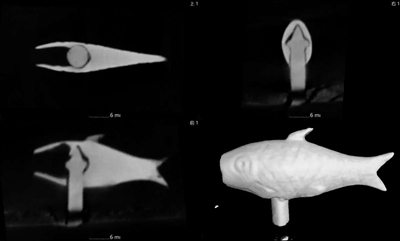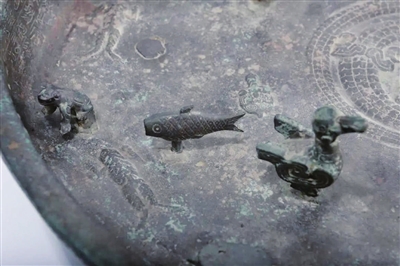This article is transferred from: Taiyuan Daily
-
-
-
-

- Part of the Jin Gongpan and its X-ray map (collected by Shanxi Museum)
-
Wang Jia
The treasure of the town hall of Shanxi Bronze Museum—Jin Gongpan is a dowry vessel made by Jin Wengong for his married daughter Meng Ji. It embodies the casting strength and skillful skills of Jin craftsmen at that time.
There are altogether 19 round-carved animals and 17 relief animals decorated in the Jingong Pan. Not only are they well-arranged, but what is even more peculiar is that the round-carved animals can rotate flexibly and freely. How is this possible? According to X-ray-CT tomographic scanning technology, experts restored the multiple split casting process of Jin Gongpan, revealing the casting mystery 2600 years ago for us. “X-ray-CT tomography technology” is the most advanced method for non-destructive structural analysis of objects. According to the change of object density and key relationship, the imaging is simulated to reflect the fine structure, and the forming process and auxiliary processing methods of the object are judged accordingly. This technology is widely used in many fields such as bronze ware, porcelain, lacquered wood ware, and casting molds, and has accumulated a large amount of data, especially in the field of ancient bronze ware technology research.
The multiple split casting process of Jin Gongpan is as follows:
1. Casting with ears. The hollow ear is cast first, and the mud core is divided into two parts; two short beams are set on the inner side of the ear to strengthen the connection with the plate.
Second, cast the human form with three legs respectively. The three legs are separately cast, and the welding port is reserved on the back, which is connected to the plate by casting welding.
3. Casting disc body. The tray is combined with multiple parts and decorations. Both the ear ends and the outer ends of the crossbeam extend into the mold of the pan, and are cast and connected to the pan wall after pouring. Inscriptions were cast on the inner wall of the dish after pouring. At the same time, tenons are cast under the tripod to prepare for casting and welding with the tripod; 19 technological holes need to be cast at the bottom of the plate to cast and weld the cylinder.
Four, casting and welding tripod. Cast and weld the tripods on the joints of the feet.
5. Separately cast round animals. The round-carved animal fits with the cylinder. First cast the cylinder with a larger column head, and then wrap the cylinder in the clay core of the round-carved animal.
6. Casting and welding round sculptures of animals. Insert the column heads connected with the round carved animals into the process holes at the bottom of the plate, pour bronze from the outside of the plate, and cast and weld the cylinders on the bottom of the plate one by one.
It can be seen that the casting of Jin Gongpan is not a simple model pouring, but a series of complex designs and rigorous process combinations to create this rare masterpiece.
The agility of the Jingong plate is due to the flexible rotating animal components in the plate, so how can these animal components rotate?
Taking the central bird as an example, the longitudinal section of the CT scan clearly shows that the column is inserted straight into the belly of the bird, and there is a protruding ring protruding forward in the belly of the bird. The upright column passes through this ring, and the matching gap with it is very small, and the inner arc of the upright column at the matching place, the diameter becomes smaller, but a cam is arranged on the upper upright column, and the diameter is larger than the exposed part, so the bird cannot be disengaged from the upright column. The stigma is conical, and to match it, a cone shank is designed on the inside of the bird’s back to protrude from the inner surface to stabilize the position of the stigma.
The right front fish upright column is consistent with that of the bird, and fits closely with the fish belly. The cross-section is perfectly round. It is very small and can ensure that the fish is in a balanced state, so that it can rotate flexibly without falling off. It seems that it is full of “black technology”.


